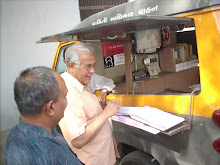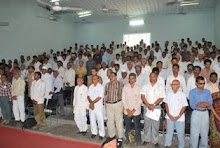The Hindu: Madras: Saturday, October 04, 2014.
Recent orders
of the Madras High Court have redefined the RTI Act reducing its scope,
expanding its restrictions and creating new grounds for denial of information
 |
| The RTI Act allows for citizens' access to information without anyone asking for it. Picture shows citizens in Karnataka demanding the implementation of the Act. Photo: K. Gopinathan |
The RTI Act
allows for citizens’ access to information without anyone asking for it.
Section 4 of the Act states that information ought to be provided by public
authorities suo motu to the public at regular intervals through various means
of communications, including internet, so that the public have minimum resort
to the use of this Act. Further, information which is not exempted and certain
information which, even if exempted, can be provided if larger public interest
is shown. Only with reference to this that the identity of the individual and
the reasons for seeking information become necessary to ascertain whether any
larger public interest is involved. It is with regard to this section that the
Madras High Court bench’s recent assertion “furnishing of those information
will hinder the regular, smooth and proper functioning of the institution [and]
cannot be given unnecessarily warranting scrupulous litigations” requires
further rectification. The court’s assertion is in direct contradiction with
the preamble of the RTI Act which states that the RTI is “an Act to provide for
setting out the practical regime of right to information.”
Besides this,
several walls of secrecy have been erected around access to information by
three division bench orders of the Madras High Court which require examining.
No
enforceable legal right
In Registrar
General v. K. Elango, the court said: “Further we are of considered view that
the applicant has no locus standi to seek details sought by him.” What the
court’s order implies is that an information seeker under the RTI does not have
the right to bring an action, to be heard in court, or to address the court on
a matter before it. The September 17 order reiterated this point by asserting
that the applicant has no enforceable legal right. If this is how the law is
interpreted, then the citizen’s right to information almost stands abolished.
By way of
judicial activism a PIL was created earlier to reduce the rigour of the rule of
locus standi. A common man will not be in a position to understand why a High
Court should reintroduce this rule in the context of RTI. By relaxing locus
standi, the previous PIL alleviated the sufferings of the aggrieved party who
could not approach courts. In the rectification order of the Madras High Court,
only two paragraphs opposing Section 6(2) were removed, but the wall of secrecy
through invocation of the rule of locus standi remains.
No file
notings
In The
Registrar General v. K. Elango judgment, the court says: “Notings, jottings,
administrative letters, intricate internal discussions, deliberations etc. of
the High Court cannot be brought under Section 2(j) of the RTI.” The RTI Act
and several judgements upheld file notings as part of information that could be
legitimately accessed. In the September 17 order, the division Bench said: “It
will have an adverse impact on the regular, normal and serene functioning of
the High Court office on the administrative side.” Para 22 containing approval
of this order has been deleted. But the orders in the Elango and Registrar
General High Court of Madras v. R.M. Subramanian cases (2013) remain. Thus,
public authorities may find a new ground to stonewall RTI questions saying they
will affect their “serene” functioning.
Referring to
the complaint that file notings were not given, the September 17 order says
that such information cannot be denied as held in the Elango case. This
paragraph has not been deleted. Thus the wall of no file notings has been
resurrected. In Para 25, the judgment says: “Furnishing of those information
will certainly impede and hinder the regular, smooth and proper functioning of
the institution, unnecessarily warranting scrupulous litigation.” In this para,
where the Bench has insisted on revealing reasons and has raised the issue of
locus standi of the respondent in seeking information, the rectification effect
has to be doubted.
Privacy of
High Court
In the Elango
case the High Court says: “Information should be denied for the purpose of
maintaining utmost confidentiality and secrecy of the delicate functioning of
the internal matters of High Courts. Usage of undefined expressions such as
“delicate functioning,” “utmost confidentiality,” “secrecy,” and “delicate
functioning” in these orders will ensure that the right to access information
further shrinks.
The matter is
sub judice and is pending before the court. According to Section 8(1)(b), only
when there is a specific prohibition by the court can information be denied.
Sub judice was not a ground for denial; yet, Para 27 of the judgment states
that it is.
The secrecy
and privacy of the internal working process may get jeopardised. Besides, the
furnishing of the said information would result in the invasion of privacy of
the individuals concerned. Privacy is an integral part of the right to life of
persons as explained by the judiciary. Can institutions then claim privacy?
The Chief
Justice of the High Court can be provided with enough freedom and inbuilt
safeguards in exercising his discretionary powers either to furnish the
information or not part with it (Para 94 of Registrar General High Court of
Madras v. R.M. Subramanian, 2013). This means the office of the Chief Justice
of High Court is totally exempted, which was not the intention of the legislation.
If the 2013 order operates as law, the question can judiciary legislate against
Parliament remains.
The courts
will always try to find out whether the applicant has sought the information
with bona fide intention and whether such information has any relevance for his
request. If it is so, each PIO will decide the fate of the RTI based on his
understanding of relevance another iron wall indeed.
The September
17 order used expressions like “not in a position to understand” (Para 29) and
“cannot be furnished.” It says: “[The] furnishing of information with regard to
the Registrar General which has been acted by the Honourable Chief Justice of
Madras High Court cannot be brought under the purview of Section 2(j) of the
RTI, as such information pertains to the internal intricate functioning/
administration of the High Court.” It also says: Posting of Registrar General
by [the] Chief Justice is in exercise of powers under Article 229 of the
Constitution and [the] appellant or any person, including other judges, has no
say. Hence information about it cannot be given.” This proves that there is a
wall of secrecy built around the process of appointment of the Registrar
General; the Supreme Court on the other hand had held that correspondence on appointment
of judges should be disclosed.
Finally, Para
30 of the order says RTI cannot be the way to redress grievance. There is no
such prohibition in the law. If the mechanism of redressal of grievance is
lacking, the citizen will a file complaint and then an RTI to know its status.
Why should he not be informed about action on complaint?
The three orders
have redefined the RTI Act reducing its scope, expanding its restrictions,
creating new grounds for denial of information and claiming total exemption to
its administration. They need to be reviewed so that the walls of secrecy can
be demolished.
(Madabhushi
Sridhar is Central Information Commissioner.)














































































